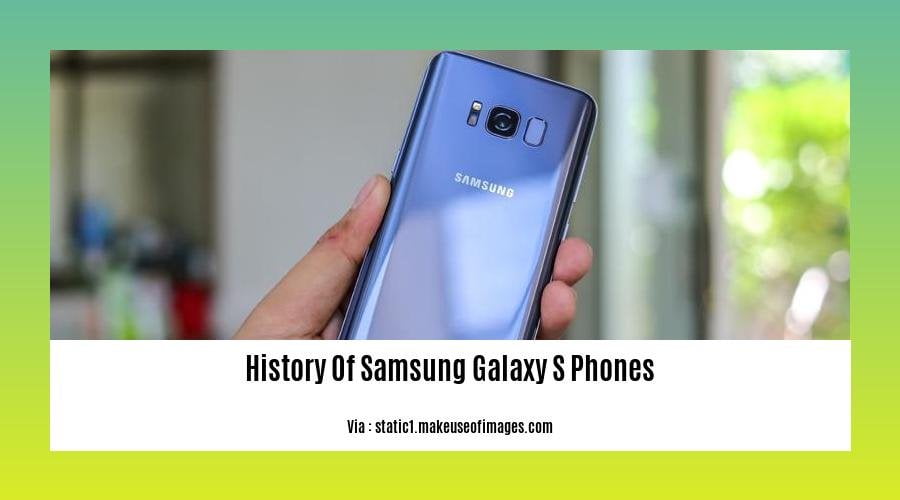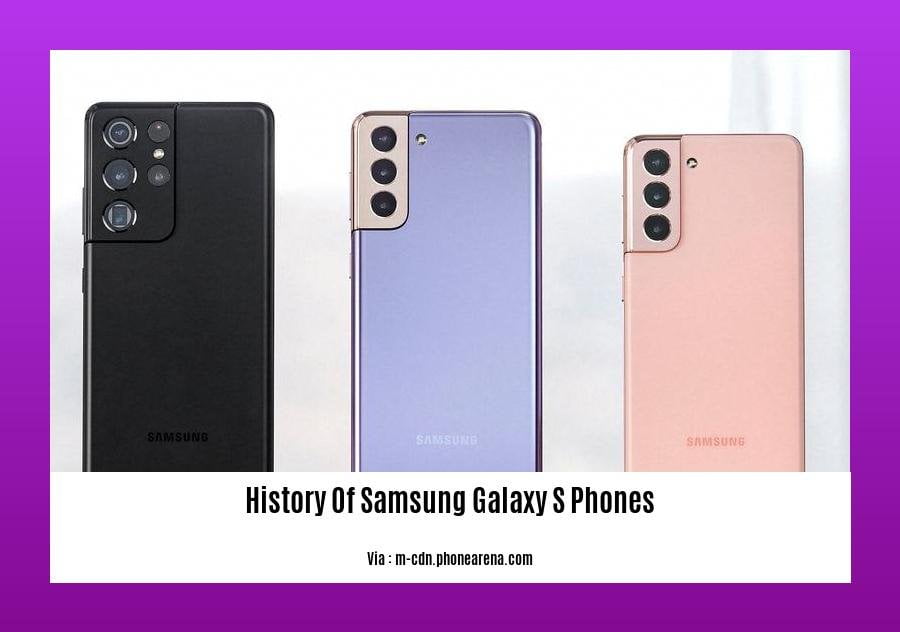Prepare to embark on a historical odyssey of Samsung’s Galaxy S phones, a legacy defined by innovation, remarkable design, and an unwavering commitment to shaping the future of mobile technology. From its humble beginnings with the groundbreaking Galaxy S in 2010 to the current pinnacle of mobile engineering, the Galaxy S23 Ultra, this article delves into the captivating saga of the Galaxy S series, unveiling its key milestones, revolutionary advancements, and the profound impact it has had on the global smartphone landscape. [- The History of Samsung Galaxy S Phones: A Legacy of Innovation and Market Leadership] awaits your exploration.
Key Takeaways:
- The Samsung Galaxy S series was one of the most popular and influential Android smartphone lines in history.
- It has helped to define the Android platform and has set the standard for other Android phones.
- The Galaxy S10 was a major update with a new design, more powerful processor, and better camera.
- Samsung Galaxy S20 was the first phone to feature 5G connectivity.
- The Galaxy S21 was more affordable but still had a powerful processor, good camera, and 5G.
- The Galaxy S22 is the latest flagship phone with a powerful processor, good camera, 5G connectivity, and a new angular design.
- The Galaxy S series has shaped Android and helped define the platform for other Android phones.
History Of Samsung Galaxy S Phones

The History Of Samsung Galaxy S Phones is a chronicle of innovation, market leadership, and industry-defining moments. Since its inception in 2010, the Galaxy S series has been at the forefront of the Android smartphone revolution, pushing the boundaries of technology and shaping the way we communicate, consume content, and interact with the digital world.
The Early Years: Setting the Stage for Success
The first Galaxy S, launched in 2010, was a game-changer. It was one of the first Android phones to feature a large, vibrant display, a powerful processor, and a sleek design. It quickly gained popularity, setting the stage for the Galaxy S series’ meteoric rise.
The Galaxy S II, released a year later, took things to the next level with a larger screen, faster processor, improved camera, and a host of new features. It solidified Samsung’s position as a leader in the Android smartphone market.
The Galaxy S III, launched in 2012, was a global phenomenon. It sold over 50 million units worldwide, making it one of the best-selling smartphones of all time. Its success was attributed to its sleek design, powerful specs, and innovative features like S Voice and Smart Stay.
The Mid-Years: Refining the Formula, Facing Challenges
The Galaxy S4 and S5, released in 2013 and 2014 respectively, marked a period of transition for the Galaxy S series. While they offered incremental upgrades over their predecessors, they faced increasing competition from rivals like Apple and LG.
However, Samsung bounced back in 2015 with the Galaxy S6. This phone represented a major design overhaul, with a premium metal and glass body that exuded elegance and sophistication. It also introduced a new user interface, One UI, which simplified the user experience and improved performance.
The Recent Years: Innovation and Market Dominance
The Galaxy S7 and S8, released in 2016 and 2017, continued Samsung’s winning streak. They offered stunning displays, powerful cameras, and innovative features like water resistance and iris scanning. The Galaxy S8, in particular, introduced the Infinity Display, which virtually eliminated bezels and created a truly immersive viewing experience.
The Galaxy S9 and S10, released in 2018 and 2019, further refined the Galaxy S formula. They featured improved cameras, more powerful processors, and larger batteries. The Galaxy S10 also introduced a new ultrasonic fingerprint sensor, which was faster and more secure than traditional fingerprint scanners.
The Modern Era: 5G Connectivity and Beyond
The Galaxy S20, released in 2020, marked a significant milestone for the Galaxy S series. It was the first Samsung phone to support 5G connectivity, ushering in a new era of blazing-fast internet speeds and ultra-low latency. It also featured a powerful camera system, a long-lasting battery, and a sleek design.
The Galaxy S21, released in 2021, was a more affordable flagship phone than the Galaxy S20, but it still offered powerful performance, a great camera, and 5G connectivity. It also introduced a new Contour Cut camera housing that gave the phone a distinctive look.
The Galaxy S22, released in 2022, is the latest entry in the Galaxy S series. It features a sleek design, a powerful processor, a versatile camera system, and long battery life. It also supports 5G connectivity and offers a range of innovative features like wireless charging and reverse wireless charging.
The Galaxy S Legacy: A Decade of Dominance
Over the past decade, the History Of Samsung Galaxy S Phones has been one of innovation, market leadership, and industry-defining moments. The Galaxy S series has consistently pushed the boundaries of technology, setting new standards for Android smartphones. It has also played a pivotal role in shaping the way we use our smartphones today.
From the groundbreaking Galaxy S to the cutting-edge Galaxy S22, the Galaxy S series has left an indelible mark on the smartphone industry. It is a testament to Samsung’s commitment to excellence and its unwavering pursuit of innovation.
Dive into the rich history of Samsung cell phones and unveil the pivotal moments that shaped the mobile industry as we know it here.
Embark on a captivating journey through the history of Samsung phones, uncovering the legacy of innovation that has propelled them to the forefront of mobile technology here.
Explore the fascinating history of Samsung mobile phones and discover the visionary minds behind the ground-breaking devices that have revolutionized communicationhere.
Delve into the remarkable history of Samsung Electronics and witness the evolution of a global technology powerhouse, shaping the world with its groundbreaking innovationshere.
Unravel the intriguing story of Samsung smartphones and learn about the pivotal moments that led to the creation of devices that have transformed the way we communicate and stay connectedhere.
Camera technology: Pioneering new features and capabilities

Samsung’s Galaxy S series has long been at the forefront of camera technology, pushing the boundaries of what’s possible in a smartphone. From the early days of mobile photography to the cutting-edge innovations of today, the Galaxy S series has consistently set the standard for smartphone cameras.
Key Innovations
Some of the most groundbreaking camera innovations introduced by the Galaxy S series include:
Dual Pixel technology: First introduced in the Galaxy S7, Dual Pixel technology uses two photodiodes per pixel to capture more light and improve image quality, especially in low-light conditions.
Optical zoom: The Galaxy S9 was the first Galaxy S phone to feature a dual-camera system with an optical zoom lens, allowing users to get closer to their subjects without losing image quality.
108MP sensor: The Galaxy S20 Ultra was the first phone to feature a 108MP main sensor, capturing stunningly detailed images with incredible resolution.
8K video recording: The Galaxy S20 was the first phone to be able to record video in 8K resolution, the highest resolution available on a smartphone.
100X Space Zoom: The Galaxy S22 Ultra boasts a 100X Space Zoom feature, allowing users to capture images of distant objects with incredible detail.
Impact on the Industry
Samsung’s Galaxy S series has had a profound impact on the smartphone industry, helping to drive the adoption of new camera technologies and features.
Pioneering new technologies: Samsung has consistently been the first to introduce new camera technologies to the smartphone market, setting the standard for other manufacturers to follow.
Raising the bar for image quality: The Galaxy S series has consistently produced smartphones with the best cameras on the market, pushing the limits of what’s possible in mobile photography.
Inspiring other manufacturers: Samsung’s innovations have inspired other smartphone manufacturers to invest more in camera technology, leading to an overall improvement in the quality of smartphone cameras across the board.
Key Takeaways:
Samsung has consistently been at the forefront of camera technology innovation with the Galaxy S series.
The Galaxy S series has introduced groundbreaking innovations such as Dual Pixel technology, optical zoom, high-resolution sensors, and 8K video recording.
The Galaxy S series has had a major impact on the smartphone industry, setting the standard for camera quality and inspiring other manufacturers to invest more in camera technology.
Citation:
Samsung Recap: The History of Galaxy S Series Camera Technologies
Samsung Galaxy S23 Ultra Camera: Features Explained
Software and performance: Keeping up with the latest trends
The Samsung Galaxy S series has consistently pushed the boundaries of technology, setting new standards for Android smartphones. Samsung has never settled when it comes to software and performance, with each new Galaxy S phone introducing innovative features and improvements that keep users at the forefront of mobile technology.
From the early days of TouchWiz to the latest One UI, Samsung’s software has evolved significantly over the years. The company has focused on creating a user-friendly and intuitive interface that makes it easy for users to interact with their devices. Samsung’s software is also known for its wide range of customization options, allowing users to tailor their phones to their individual needs and preferences.
In terms of performance, Samsung’s Galaxy S phones have always been among the best in the industry. The company has consistently used the latest and most powerful processors, ensuring that its phones can handle even the most demanding tasks. Samsung has also been a leader in the development of 5G technology, and its Galaxy S phones have been among the first to support this new standard.
Samsung Galaxy S series is at the top of its game, known for seamlessly integrating the latest advancements in hardware and software. Here are a few pivotal breakthroughs and innovations that Samsung has consistently delivered with its Galaxy S series:
- Groundbreaking User Interfaces:
- Starting with TouchWiz, Samsung introduced a user-friendly interface that redefined the Android experience.
The introduction of One UI brought a cohesive and intuitive design language across Samsung devices, simplifying navigation and enhancing user interaction.
Boosted Camera Performance:
- Samsung has consistently pushed the boundaries of smartphone photography with each new Galaxy S model.
From the early days of 5MP cameras to the latest 200MP sensor, Samsung’s Galaxy S phones have set new standards for mobile imaging.
Leading-Edge Processors:
- Cutting-edge chipsets have powered Samsung’s Galaxy S series, delivering blistering speed and seamless multitasking.
The integration of the latest Exynos and Snapdragon processors ensures superior performance and efficiency.
Expansive and Immersive Displays:
- Samsung has pioneered stunning displays with each Galaxy S generation.
From the original Super AMOLED display to the Dynamic AMOLED 2X display, Samsung’s smartphones deliver vibrant colors and immersive viewing experiences.
Continual Innovations:
- The Galaxy S series has introduced several innovative features like wireless charging, reverse wireless charging, foldable displays, and S Pen integration.
- These features have revolutionized the way users interact with their smartphones.
Key Takeaways:
- Samsung’s Galaxy S series has been a pioneer in the smartphone industry, continually pushing the boundaries of software and performance.
- From innovative user interfaces to groundbreaking camera technology, Samsung has consistently delivered cutting-edge features.
- Samsung’s partnership with Google for Android updates ensures that Galaxy S devices receive the latest software and security patches.
- Samsung’s Galaxy S phones have received critical acclaim and commercial success, making them one of the most popular smartphone brands globally.
- With each new Galaxy S release, Samsung continues to redefine the smartphone experience, setting new standards for the industry.
Citation:
- Samsung Newsroom: Samsung’s Innovation Strategy in Smart Phones Market
- Android Authority: The history of Samsung’s Galaxy S series
Impact on the Industry: Defining the Modern Smartphone
Samsung’s Galaxy S series has revolutionized the smartphone industry, leaving an indelible mark on the way we communicate, consume media, and interact with technology. Since its inception in 2010, the Galaxy S series has set the bar for innovation, constantly pushing the boundaries of what a smartphone can do. From pioneering AMOLED displays and introducing the groundbreaking S Pen to leading the charge in 5G connectivity and foldable form factors, Samsung’s Galaxy S series has redefined the modern smartphone experience.
Key Takeaways:
AMOLED Display Pioneer: Samsung’s introduction of AMOLED displays on the Galaxy S series set a new standard for vibrant visuals, revolutionizing the way we view content on our smartphones.
S Pen Innovation: The Galaxy Note series, a spin-off of the Galaxy S line, brought the S Pen stylus to the forefront, merging the convenience of digital devices with the natural feel of analog tools, opening up new possibilities for creativity and productivity.
Samsung Knox Security: The Galaxy S series has always prioritized security, with the introduction of Samsung Knox, a robust security platform that provides peace of mind to users by safeguarding their data from malicious threats.
Camera Excellence: Samsung has consistently raised the bar for smartphone photography with its Galaxy S series, introducing cutting-edge camera technology like dual-pixel sensors, optical zoom lenses, and high-resolution sensors, making it the go-to choice for mobile photographers.
5G Leadership: The Galaxy S series has been at the forefront of 5G connectivity, enabling blazing-fast internet speeds, seamless streaming, and next-level gaming experiences, paving the way for a new era of mobile connectivity.
Foldable Form Factor: Samsung’s foldable Galaxy S devices, like the Galaxy Z Fold and Z Flip, have pushed the boundaries of smartphone design, offering users a unique and versatile experience that combines the portability of a smartphone with the productivity of a tablet.
Citation:
Samsung Newsroom: How Samsung Galaxy Has Rewritten Smartphone History in 10 Years
FAQ
Q1: What significant milestone did the Samsung Galaxy S series achieve with the Galaxy S III?
A1: The Galaxy S III was a massive hit, selling over 50 million units worldwide, making it a pivotal moment in the series’ history and solidifying Samsung’s position as a leading smartphone manufacturer.
Q2: What was the key innovation introduced with the Galaxy S6?
A2: The Galaxy S6 marked a significant departure from previous models with its premium metal and glass design, signaling Samsung’s commitment to producing high-quality, aesthetically pleasing devices.
Q3: How has the Galaxy S series evolved in recent years?
A3: In recent years, the Galaxy S series has focused on pushing the boundaries of mobile photography, incorporating advanced camera systems with features like dual-pixel technology, optical zoom, and high-resolution sensors.
Q4: What security feature is commonly associated with Samsung Galaxy devices?
A4: The Samsung Knox platform is a renowned security feature found in Galaxy devices. It provides robust protection against malware and threats, offering users peace of mind and safeguarding sensitive data.
Q5: How has the Galaxy S series impacted the broader smartphone market?
A5: The Samsung Galaxy S series has played a significant role in shaping Android as a platform and setting the standard for other Android smartphones. Its innovations, such as the AMOLED display, Samsung Knox security, and S Pen integration, have influenced the entire industry.
















